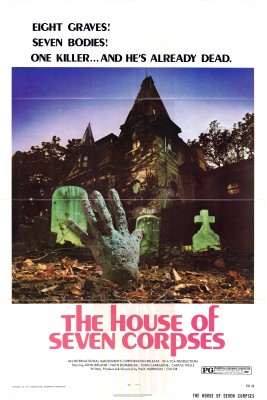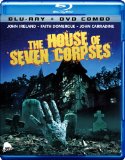| Reviews & Columns |
|
Reviews DVD TV on DVD Blu-ray 4K UHD International DVDs In Theaters Reviews by Studio Video Games Features Collector Series DVDs Easter Egg Database Interviews DVD Talk Radio Feature Articles Columns Anime Talk DVD Savant Horror DVDs The M.O.D. Squad Art House HD Talk Silent DVD
|
DVD Talk Forum |
|
|
| Resources |
|
DVD Price Search Customer Service #'s RCE Info Links |
|
Columns
|
|
|
House Of Seven Corpses, The
The movie was made by something called the Television Corporation of America, an entity that seems to have made no other movies, nor is it likely they were related to the same-named company that produced Abbott & Costello's TV show back in the early fifties. The short-lived International Amusements Corp. distributed The House of Seven Corpses, along with a baker's dozen of other cheap films, mostly horror and sexploitation films, during 1969-74. It's possible, even likely, they were a subsidiary of Sumner Redstone's National Amusements theater chain, and that these pictures served to provide product to his drive-ins.
Regardless, the film's relative obscurity has made it a bit harder to see than, say, contemporaneous AIP and Hammer titles. I'd seen it some years ago when the Geneon label released it to DVD in 2005, but that release was pretty shoddy and the video transfer was poor.
Severin's new Blu-ray, on the other hand, is a vast improvement in every way. Though it sources imperfect film elements, apparently a 35mm print judging by the reel change cues and other damage (including a melted-in-the-projector damaged frame) the image is impressively sharp with accurate color. The extras are good and include an audio commentary track and a half-hour video interview with co-star John Carradine from 1983.
The movie opens with a woman (Faith Domergue) engaged in some sort of Satanic ritual similar to The Devil Rides Out and other films. But this turns out to be a cheat. Director Eric Hartman (John Ireland) shouts "Cut!" when Edgar Price (John Carradine), caretaker of the old mansion serving as the film's main location, ruins a take. (Frankenstein: 1970 opens the same way.)
The cavernous mansion has a dark past, where seven previous owners died violent and mysterious deaths, depicted under the impressively creepy main titles. The movie within the movie appears to be a fictionalized account of the haunted mansion's grim history.
The never-named movie in production is dramatized in ways that at times are fairly realistic about the trials and tribulations of low-budget moviemaking, while in other respects fall back on clichés and inaccuracies about movie production. Some takes, for instance, are unrealistically long with complex blocking a single camera couldn't possibly cover, and the direction Hartman gives his actors doesn't ring true, either. Another stereotype: the leading man, Christopher Millan (Charles Macauley), is a John Barrymore-esque alcoholic, a bald man fitted with a strange wig for the film that makes him look like Laugh-In announcer Garry Owens.
On the other hand, Hartman and his leading lady, middle-aged Gayle Dorian (Domergue) have a believable past. They were once lovers and major talents that, 20 years before, worked at Hollywood's biggest studios. "A good day's work!" she huffs when Hartman compliments his crew. "At Metro that would have been a week's work!" He's obviously under a lot of pressure to get the film shot as cheaply and quickly as possible, while she's constantly irritable, reluctant to admit that she's all but washed up. (Domergue was about 50 at the time, her once exotic beauty, reminiscent of Ava Gardner, long faded. This was her penultimate movie role.)
Anne (Carole Wells) and David (Jerry Strickler) are the ingénue and hero, while Ron (Ron Foreman), is the jack-of-all-trades crewmember who seems to be a combination make-up man, clapper boy, and costumer. Other crew mull about but have few lines.
At various times, Gayle's readings alternate between what seem to be intended as black magic incantations but she's actually seen holding The Book of Daniel in some scenes and The Tibetan Book of the Dead in others. Nevertheless, somehow all this regenerates a corpse in an adjacent graveyard (a fairly effective makeup) who comes-a-callin'. Amusingly, the movie intercuts his resurrection with the fake one being filmed for the movie.
Though not scary, Ireland, Domergue, and Carradine give the film a bit of theatrical weight, and the musical score, apparently part original (including an eerie choral arrangement), part stock music (allegedly fromThe Outer Limits) add a certain creepiness. A mansion formerly occupied by the Governor of Utah served as the main location for all interiors and nearby exteriors, and it's properly mysterious and sinister looking.
Video & Audio
The House of Seven Corpses is listed on the packaging as running 91 minutes but the actual running time is closer to 88 minutes. Nonetheless the film appears to be uncut and reportedly "transferred in in HD from original vault elements." Reel change cues are highly visible (at 32:23, for instance), some chemical damage mars the first reel, and there's a big burn hole in a frame at the 50:01 mark. Nonetheless, it's a big, BIG improvement over what's been available before, and most of the time the image is sharp with strong color. One scene near the end, possibly true to original release prints, is badly timed. A graveyard sequence is shot day-for-night but not darkened so the effect looks like mid-day. In a quick series of shots John Ireland covers a couple hundred feet from what appears high noon to midnight in about 15 seconds. The English mono audio is pretty rough, but that's because of the cavernous recording conditions and absence of post-production looping and not the Blu-ray's fault. No subtitles.
Extra Features
Supplements include an audio commentary with associate producer Gary Kent, moderated by the Alamo Drafthouse's Lars Nilsen. An effective original trailer is also included, but the real bonus is a 30-minute John Carradine interview from 1983, a few years before the actor's death. (His arthritis was so bad by this point his pinkies jut out at 90-degree angles from his hand.) Carradine is deadly serious throughout but was also a notorious teller of tall tales, so viewers are advised not to take his anecdotes at face value.
Parting Thoughts
For genre fans, The House of Seven Corpses is a most welcome release and Highly Recommended.
Stuart Galbraith IV is a Kyoto-based film historian whose work includes film history books, DVD and Blu-ray audio commentaries and special features. Visit Stuart's Cine Blogarama here.
|
| Popular Reviews |
| Sponsored Links |
|
|
| Sponsored Links |
|
|
| Release List | Reviews | Shop | Newsletter | Forum | DVD Giveaways | Blu-Ray | Advertise |
|
Copyright 2024 DVDTalk.com All Rights Reserved. Legal Info, Privacy Policy, Terms of Use,
Manage Preferences,
Your Privacy Choices | |||||||














